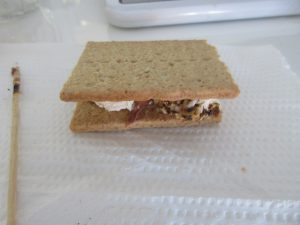This lab is the first time ever that we were allowed to actually eat the experimental product which is the s’more. After learning how to balance the chemistry equation, experimental and theoretical yield, and limiting and excess reactants we simulate this lab to further our understanding in those areas. Limiting reactant is the reactant is all used in the experiment and excess reactant is the reactant is leftover in the experiment. Experimental yield is the actual product that we got in the experiment and in this case is the mass of the s’more and theoretical yields is the product that we should get. After the experiment, my team actually found out that the percent yield is 101% because our experimental yield is bigger than our theoretical yields, the denominator.
Chemistry: Flame Test Lab
Objective: To observe the relationship between various elements and their emission spectrum.
Introduction:
Flame tests provide a way to qualitatively test for the presence of specific elements by seeing colored flames. The heat of the bunsen burner excites the electrons in the atom, and this energy is released as the electrons “fall back” to their ground states. The color we see is a combination of the visible wavelengths of light emitted by the atoms.
If you have a spectroscope you can also make quantitative observations. A spectroscope can be used to see a pattern of narrow lights called an emission (bright-line) spectrum. The actually wavelengths of the spectrum serve as a quantitative test to determine atoms identities. Each element has a different “pattern” of electrons, so it will show a different combination of colors.
In this lab you will perform flame tests on seven different elements. You will use your observations to identify an unknown solution.
Prelaboratory Questions: (In a section labeled PRELAB- answer the following questions in FULL sentences)
- Why do we see colors in the flame tests?
- We see color in the flame lab because the bunsen burner excites the electrons i the atom, and the energy is released as electrons and showing the quantized energy which we see the color.
- How will we be testing the substances qualitatively?
- We will testing the substance qualitatively by observing the color of different salt compound and check the wavelength of those color.
Materials:
Safety goggles , wood splints, tongs/tweezers, Bunsen burner, test tubes with various compounds
Safety:
- Safety goggles must be worn at all times
- Many of these salts are toxic. If you come into contact with any of the compounds make sure to notify teacher and wash the contacted area thoroughly. Wash your hands before leaving the lab!
Procedure:
- Light the Bunsen burner (turn the gas on so you can just hear it, then use the striker)
- Place the wood splint for each compound into the flame using tongs or tweezers- ONE AT A TIME!
- Take note of the color of the flame and return the wood splint to the solution.
- CLEAN UP YOUR STATION! Carefully put the stoppers back on the solutions! Make sure the station looks like it did when you started! Let me know if you need new splints!
- Wash your hands thoroughly before leaving the laboratory
Data Table: make a section of your lab labeled Data Table and make a data table similar to the one below to record your observations.
Compound |
Color of Flame (qualitative) |
Wavelengths of light (in Å) (quantitative) |
| Barium Chloride | Yellow | 570 nm – 590 nm |
| Calcium Chloride | Orange-ish-red | Orange: 590 nm – 620 nm
Red: 620 nm – 750 nm |
| Copper (II) Chloride | Green (abit Blue) | Green: 495 nm – 570 nm
Blue: 450 nm – 495 nm |
| Lithium Chloride | Red-ish-pink | 620 nm – 750 nm |
| Potassium Chloride | Orange | 590 nm – 620 nm |
| Strontium Chloride | Red | 620 nm – 750 nm |
Unknown #1 |
Red-ish-violet | Red: 620 nm – 750 nm
Violet: 380 nm – 450 nm |
Discussion and Analysis: (In a section labeled Discussion and Analysis answer the following questions in complete sentences)
- How do your results from the flame test provide support for quantized energy levels? Explain your answer.
- The results from the flame test provide support for quantized energy by the number of the wavelength that we know from the color of each of the salt compound.
- The unknown compound is one of the other six. Identify it and explain HOW you figured it out using the results of your experiment.
- The unknown compound is one of the other six, and I think it is the Lithium Chloride because they have the same quantized energy and during the experiment the color of both compound is the same.
Conclusion: (answer in a complete paragraph and in complete sentences)
What are two possible sources of error for this lab. How would the errors affect your lab? What would you do differently next time to counteract these errors?
- The two possible sources of error for this lab would be the drop of the previous chloride onto the flame in which will cause in bias result of color of the next compound. Another one is about how we interpret the color where it will lead to different interpretation of the wavelength or quantized energy of each of the compound. So the next time we do this lab we will need to make sure the flame is clean after testing for one compound before testing another compound. And trying to do more replications for each of the compound so that we get the valid result which mean the valid color and quantized energy.



